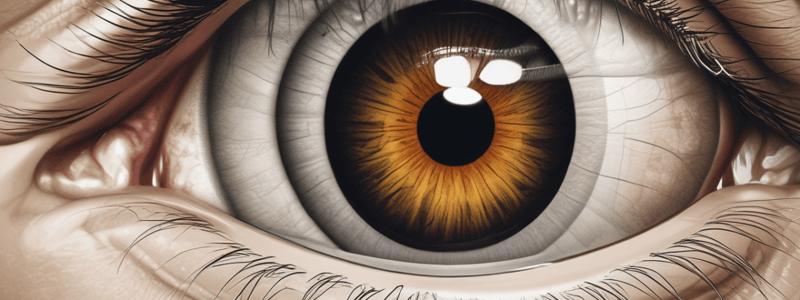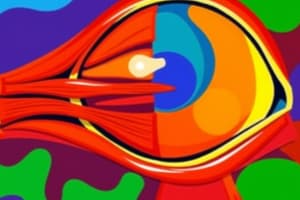Podcast
Questions and Answers
What is the term for the error of alignment that occurs when fusion is suspended?
What is the term for the error of alignment that occurs when fusion is suspended?
- Heterophoria (correct)
- Phoria
- Tropia
- Orthophoria
In normal individuals, the eyes always remain exactly parallel on dissociation.
In normal individuals, the eyes always remain exactly parallel on dissociation.
False (B)
What is the purpose of the cover test?
What is the purpose of the cover test?
To diagnose the presence of a heterophoria and heterotropia
Distance fixation represents the error between the position of the eyes produced by tonic convergence and _______________________.
Distance fixation represents the error between the position of the eyes produced by tonic convergence and _______________________.
What is the movement seen in esophoria during the alternate cover test?
What is the movement seen in esophoria during the alternate cover test?
Match the following terms with their definitions:
Match the following terms with their definitions:
Heterophoria is a manifest deviation of the visual axes.
Heterophoria is a manifest deviation of the visual axes.
What is the term for the reflex that maintains the correct alignment of the two eyes?
What is the term for the reflex that maintains the correct alignment of the two eyes?
What is the direction of movement of the uncovered eye in Hypertropia?
What is the direction of movement of the uncovered eye in Hypertropia?
Incomitant Heterotropia is also known as non-paralytic strabismus.
Incomitant Heterotropia is also known as non-paralytic strabismus.
What is the term for the upper poles of the cornea deviating outwards?
What is the term for the upper poles of the cornea deviating outwards?
In Cyclotropia, Incyclotropia is characterized by the upper poles of the cornea deviating _____________.
In Cyclotropia, Incyclotropia is characterized by the upper poles of the cornea deviating _____________.
Match the type of Esotropia with its characteristic.
Match the type of Esotropia with its characteristic.
What happens to the secondary deviation in long-standing cases of Incomitant Heterotropia?
What happens to the secondary deviation in long-standing cases of Incomitant Heterotropia?
What is the direction of the eye's movement in exophoria during the alternate cover test?
What is the direction of the eye's movement in exophoria during the alternate cover test?
Esophoria is a type of heterophoria characterized by convergence excess.
Esophoria is a type of heterophoria characterized by convergence excess.
What is the difference between hyperphoria and hypophoria?
What is the difference between hyperphoria and hypophoria?
Incomitant heterophoria is often seen in the presence of _______________________ or mechanical strabismus.
Incomitant heterophoria is often seen in the presence of _______________________ or mechanical strabismus.
Match the following types of heterophoria with their characteristics:
Match the following types of heterophoria with their characteristics:
Heterotropia can be present in both eyes at the same time.
Heterotropia can be present in both eyes at the same time.
What is the sequence of events in the cover test for heterotropia?
What is the sequence of events in the cover test for heterotropia?
What is the term for the deviation that increases when the paretic eye is made to fixate and decreases when the fellow eye fixates?
What is the term for the deviation that increases when the paretic eye is made to fixate and decreases when the fellow eye fixates?
Flashcards are hidden until you start studying
Study Notes
Heterophoria (Latent Squint)
- Most binocular anomalies result in misalignment of the visual axes
- Fusion reflex maintains correct alignment of the two eyes
- Heterophoria is the error of alignment that takes place when fusion is suspended
- Phoria represents the error between the desired alignment of the eyes and the position produced by tonic, accommodative, and proximal convergence
Types of Phoria
- Esophoria:
- Convergence excess – deviation greater at near fixation
- Divergence weakness – deviation greater at distance fixation
- Non-specific – deviation similar at near and distance fixation
- Exophoria:
- Convergence weakness – deviation greater at near fixation
- Divergence excess – deviation greater at distance fixation
- Non-specific – deviation similar at near and distance fixation
Vertical Heterophoria
- Hyperphoria: the eye moves upwards under the cover and will then be seen to come down once the cover is removed
- Hypophoria: the eye moves downwards under the cover and will then be seen to come up once the cover is removed
- Nomenclature is determined by the high eye
Incomitant Heterophoria
- Dissociation deviation increases when one eye is made to fixate and decreases when the other eye fixates
- Or, it increases and decreases when the eyes fixate in different positions of gaze
- Aetiology: most are seen in the presence of paralytic or mechanical strabismus
- Diagnosed according to underlying cause, e.g., esophoria in 6th nerve palsy or hypophoria in TED or Hyperphoria in 4th nerve palsy
Heterotropia
- When both eyes are open, one eye will fixate the target and the other will deviate
- Cover Test (Cover – Uncover) is used to diagnose heterotropia
- Horizontal and vertical squints can coexist
- Can be in one eye or both (alternating) although not at the same time
Types of Heterotropia
- Esotropia:
- Eye is deviated inwards (convergent)
- Uncovered eye will move outwards (temporally) to take up fixation
- Exotropia:
- Eye is deviated outwards
- Uncovered eye will move inwards (nasally) to take up fixation
- Hypertropia:
- Eye is elevated upwards
- Uncovered eye moves downwards to fixate
Vertical Heterotropia
- Hypertropia: uncovered eye moves downwards to take up fixation
- Hypotropia: uncovered eye moves upwards to take up fixation
- Nomenclature is determined by the eye that shows manifest deviation
Cyclotropia
- Excyclotropia: upper poles of cornea deviate outwards
- Incyclotropia: upper poles of cornea deviate inwards
Studying That Suits You
Use AI to generate personalized quizzes and flashcards to suit your learning preferences.




